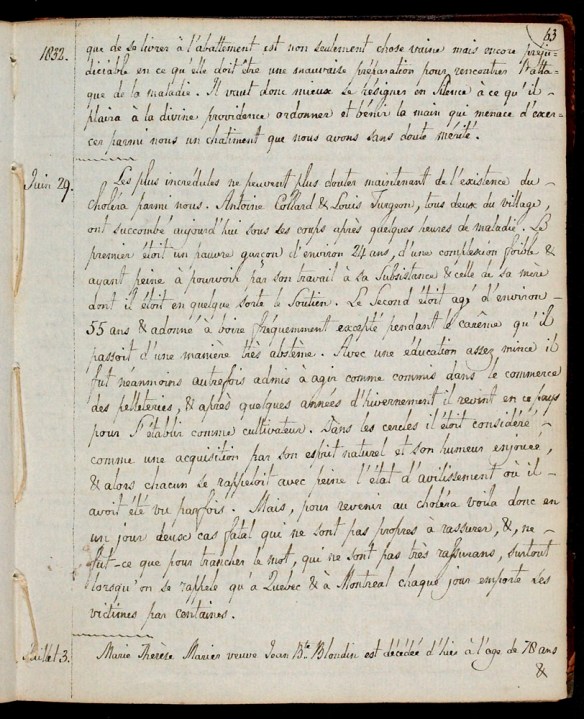
Terrebonne, 1810 (e000756681)
Genealogy serves many purposes; it can be a hobby or a way to connect with those who came before you. It can help to strengthen your identity within your community asyou learn about your ancestors and where they came from. Be warned, it can be addictive!
As enjoyable and meaningful as researching your family history can be, it can also be very frustrating. One of the challenges I encountered when answering inquiries from the public during my time with the Library and Archives Canada Genealogy team was that it is sometimes difficult to find contextual information about people in the past. It is reasonably easy to learn basic information about ancestors, such as their dates and places of birth or the names of the witnesses who signed the marriage record, but this does not tell you much about their day-to-day lives or what their communities were like.
For example, birth, marriage and death records usually contain information such as full name, year and place of birth, and name of parents. Census records contain a little more information, such as religious denomination, ethnic origin and occupation. This information is useful, but it does not complete the picture. An occupation title, such as labourer or domestic, is helpful, but does not tell you where the person worked, how long the days were, and what kind of life that person came home to in the evening. In my own research, I found that to understand why ancestors made the decisions they did, you need to see the bigger picture. This is why notary François-Hyacinthe Séguin’s journal of the Terrebonne area in Quebec was so valuable as a non-traditional genealogy resource in understanding Canadian history in the early to mid-1800s.
François-Hyacinthe Séguin received his notary commission on October 15, 1808, and he opened an office in Terrebonne, where he served the community for all of his life. Not only did he keep detailed notes of births, marriages and deaths in the small town, but he also recorded details of social, political and environmental activities in the area. The journal, written in French, spans February 7, 1831, to March 2, 1834, and is a fascinating account of religious and social life in Terrebonne. Séguin writes about a variety of subjects, such as charivaris after local weddings, the cholera epidemic in the community, a solar eclipse and the first thunderstorm of the year.

A page from Séguin’s journal, where he states that, as Antoine Collard and Louis Turgeon have died, even the doubters must now admit that there is a cholera outbreak in the community. He also gives a short—and judgmental—biography of the two men, which genealogists may find helpful. (e004158805)
Another important subject in Séguin’s journal is his account of the Patriote movement. He diligently chronicles the history and politics of the day. His entries describe local politicians who were elected but not admitted into the Legislative Assembly of Lower Canada. He also writes about tensions during recent elections and the violence that people experienced while trying to vote.
Séguin’s journal also delves into local lives. He freely expresses his feelings about friends, neighbours and relatives in terms that are not always flattering. In one of the entries, he writes about how one of his students was recently arrested and that although he knew he should feel sympathy, he did not. In his entry noting the death of a local widow, he criticizes her frugal tendencies and her lack of social interactions. While noting the death of the priest from a neighbouring town, Séguin sneaks in a critique about the clergyman’s appearance.

A page from Séguin’s journal, where topics range from a winter thunderstorm to the deaths of local residents. (e004158841)
Do you want to know more about the good, the bad and the ugly in 1831 Terrebonne? Our Co-Lab challenge is dedicated to François-Hyacinthe Séguin’s fascinating French-language journal. Each page is filled with captivating and often critical observations, which help us to deepen our understanding of what it was like to live in a small town in Quebec in the mid-1800s. You can help to transcribe Séguin’s journal in the original French, or help to translate this no-holds-barred journal into English, so Anglophones can relish Séguin’s storytelling.
Interested in learning about your own ancestors? Visit our Genealogy and family history pages.
Sara Chatfield is a project manager in the Exhibitions and Online Content Division at Library and Archives Canada.
